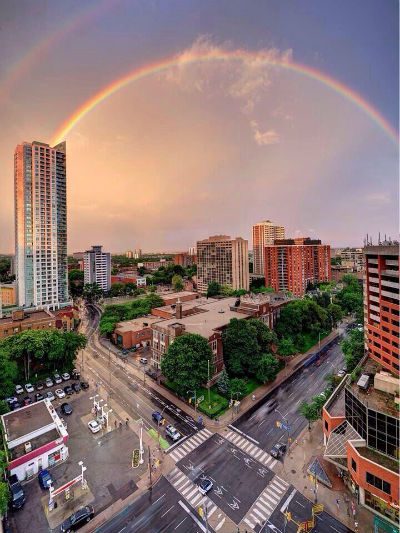Toronto shines its rainbow in celebration.
"Somewhere over the rainbow" during the month of June in Toronto, Ontario Canada, the continent of North America hosted its first World Pride. Toronto is the fourth city to host a world pride since its inception in 2000. Other cities with this honour include: Rome, Jerusalem and London. With a landscape of such popular and historic cities, one might wonder: how did Canada’s largest city do?
Upon entering the city you couldn’t help but notice the rainbow theme. Not only the affectionately named Gay District but the entire host city was adorned in rainbows. Everything from transport buses, churches, billboards, and crosswalks to the famous CN tower were dressed for the occasion in rainbow pride. Local businesses and residents joined in the celebration by posting signs indicating they were gay friendly and proud hosts. The overwhelming impression was one of welcoming and belonging.
Toronto has some experience in hosting Pride celebrations with 2014 marking its 34th Pride celebration however, this year’s World Pride Celebration marked a much larger (and global) event. The 2014 Pride Toronto Grand Marshall was not a Canadian but a Georgian LGBTQ activist, Anna Rekhviashvili.
An estimated 1.2 million people from every corner of the world were in attendance. More than 400 international delegates participated in the human rights conference and the Pride parade itself also saw a drastic increase in the number of groups registered to march. A total of 350 groups made up more than 12,500 marchers.
World pride festivities stretched over June 20th-29th. The city busted at the seams with concerts, art shows, cruises, conferences, fundraisers, and parking lot parties. Events were designed to accommodate all in attendance including Family Pride, a kid-friendly zone for GLTBTQ families and allies. Walking through the streets, it was impossible not to feel inspired by the positive events and sense the freedom.
Although the World Pride parade was the "crowning gem" in the Pride crown, there were two other marches that took place in the days that lead up to the big finale. The Trans* Pride March organised their longest march yet and the Dyke march, a grassroots demonstration, saw a record number of participants. Although both of these events boast in their title representing different groups, there was great permeability within both of these events. Lesbian and Trans persons were both represented in the two marches. The spirit of community among all groups in attendance was very much alive.
The World Pride Parade was by far the most extensive and populous event. With record numbers of participants and an extended route. Not to mention, a record number of parade onlookers. This culminating event saw in its attendance every LGBTQ group as well as noteworthy allies such as the Toronto Police Department and representatives of Catholic School Boards. The celebration was loud, blissful and extraordinarily inclusive. The tens of thousands of GLBTQ allies present to show support are an example of the social progress pride festivals create.
As the festivities wound down to a close on the 29th, over the closing ceremonies a giant rainbow stretched across the sky in a beautiful statement organizers couldn’t have timed or planned better. It has become known as the official World Pride Rainbow. While many cheered and took photos there was a consensus, a tremendous sense of awe and an affirmation. Our freedom, our hope, our pride was the pot of gold at the end of that rainbow.
For more on the Rainbow:
http://www.cbc.ca/newsblogs/yourcommunity/2014/06/rainbow-graces-toronto-sky-to-end-world-pride.html
